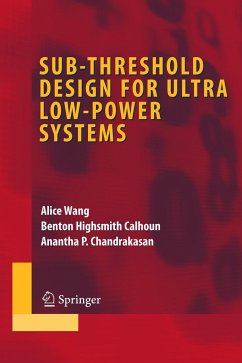The topic of sub-threshold VLSI has been discussed since the 1970's when the minimum supply voltage was theorized based on various sub-threshold models. It has been used in simple designs, such as watches and hearing aids. In new and upcoming wireless applications, such as distributed microsensors or medical applications, minimizing energy dissipation is the primary concern and has motivated investigation of the optimum design for minimizing energy dissipation or power for a given performance constraint. Sub-threshold circuits are ideal for this class of applications, thus making sub-threshold VLSI a realistic solution.
This book combines the research of two MIT graduate students, which has spawned an exciting new field of research into sub-threshold circuit and system design. The work includes the research of Alice Wang who designed the first 180mV sub-threshold processor that minimizes energy dissipation and Benton Calhoun who has worked on modeling the optimum voltage to minimize energy dissipation and has designed a sub-threshold SRAM. The book includes a survey of the field of sub-threshold and low-voltage design and will delve into various aspects of sub-threshold circuit design such as modeling, logic and memory circuit design. One important chapter of the book is dedicated to optimizing energy dissipation which is a key metric for energy constrained designs. This book also includes invited chapters about the subject of analog sub-threshold circuits.
Although energy dissipation has improved with each new technology node, because SoCs are integrating tens of million devices on-chip, the energy ex pended per operation has become a critical consideration in digital and ana log integrated circuits. The focus of this book is sub-threshold circuit design, which involves scaling voltages below the device thresholds. In this region, the energy per operation cair be reduced by an order of magnitude compared to conventional operation but at the cost of circuit performance. In many emerging applications such as self-powered RFID, wireless sensors networks, and portable devices (PDAs, medical monitoring, etc. ), the overall battery life time is the primary design metric. Sub-threshold design can also be applied to burst mode applications (e. g. , a cell-phone processor) where the process spends a significant amount of time in the standby mode. The supply voltage can be reduced to the deep sub-threshold region, dramatically saving power in logic and memory. Extremely low-power design was first explored in the 1970s for the design of applications such as wristwatch and calculator circuits. Dr. Eric Vittoz pioneered the design and modeling of weak-inversion circuits. In this book, Eric provides his perspective on the evolution of sub-threshold circuit design. Dr. Eric Vittoz and Dr. Christian Enz introduce key models necessary for the design and optimization of weak inversion circuits. Design using weak inversion has been widely adopted in analog circuits, and Eric introduces the key design considerations.
This book combines the research of two MIT graduate students, which has spawned an exciting new field of research into sub-threshold circuit and system design. The work includes the research of Alice Wang who designed the first 180mV sub-threshold processor that minimizes energy dissipation and Benton Calhoun who has worked on modeling the optimum voltage to minimize energy dissipation and has designed a sub-threshold SRAM. The book includes a survey of the field of sub-threshold and low-voltage design and will delve into various aspects of sub-threshold circuit design such as modeling, logic and memory circuit design. One important chapter of the book is dedicated to optimizing energy dissipation which is a key metric for energy constrained designs. This book also includes invited chapters about the subject of analog sub-threshold circuits.
Although energy dissipation has improved with each new technology node, because SoCs are integrating tens of million devices on-chip, the energy ex pended per operation has become a critical consideration in digital and ana log integrated circuits. The focus of this book is sub-threshold circuit design, which involves scaling voltages below the device thresholds. In this region, the energy per operation cair be reduced by an order of magnitude compared to conventional operation but at the cost of circuit performance. In many emerging applications such as self-powered RFID, wireless sensors networks, and portable devices (PDAs, medical monitoring, etc. ), the overall battery life time is the primary design metric. Sub-threshold design can also be applied to burst mode applications (e. g. , a cell-phone processor) where the process spends a significant amount of time in the standby mode. The supply voltage can be reduced to the deep sub-threshold region, dramatically saving power in logic and memory. Extremely low-power design was first explored in the 1970s for the design of applications such as wristwatch and calculator circuits. Dr. Eric Vittoz pioneered the design and modeling of weak-inversion circuits. In this book, Eric provides his perspective on the evolution of sub-threshold circuit design. Dr. Eric Vittoz and Dr. Christian Enz introduce key models necessary for the design and optimization of weak inversion circuits. Design using weak inversion has been widely adopted in analog circuits, and Eric introduces the key design considerations.








